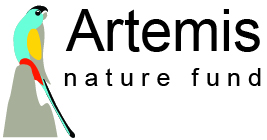
Letter of Support: Olkola Chairman Mike Ross and Golden-shouldered Parrot Recovery Team

Artemis · ·

Artemis · ·
Last week we captured two feral cats on Artemis and fitted them with GPS tracking collars. Each feral cat in Australia kills hundreds of native animals each year, are a potentially serious threat to Golden-shouldered Parrots. We need to learn more about them on Artemis, especially in the context of our habitat restoration work. We don’t want to inadvertently make the threat of feral cats even worse.
The collars will turn on for 24 hours every Friday and acquire a GPS fix every 30 minutes. They should do this for about a year. The two cats we caught last week – a male and a female – are the first of several we intend to follow like this over the next year or so. Upon completion, all cats will be humanely removed. The University of Queensland’s Animal Ethics Committee and Biosecurity Queensland have endorsed this work.
A feral cat captured on a camera trap in Artemis’ Antbed Parrot Nature Refuge in December 2019.
There are a few reasons why we need to track feral cats on Artemis.
First, we don’t really know exactly how much of a threat cats pose to adult Golden-shouldered Parrots. By comparing the activity patterns of our feral cats to what we already know about the parrots, we’ll be able to tell how much time cats spend hunting during the day when parrots are most actively feeding on the ground. We’ll be able to tell if this threat changes seasonally and therefore when is the best time to undertake cat control in order to safe-guard parrots.
Second, it’s possible that our habitat restoration work may affect the way cats use the landscape. If we do change the way cats behave, we want to know about it.
And third, it’s never a bad thing to simply learn more about this serious conservation threat. It has been estimated that feral cats kill billions of Australian native animals each year. By increasing our knowledge of cat ranging behaviour in this landscape, our cat control activities should become more effective. This includes sharing information through the Golden-shouldered Parrot Recovery Team so other groups in the region (such as the Olkola Rangers) can improve their cat management programs.
Stay tuned for regular updates about where our tagged cats move over the coming months.
Steve Murphy · ·
In July 2020 Sue Shephard and I revisited a series of photo monitoring sites on Artemis. Sue, Gay Crowley and Stephen Garnett first photographed these sites about 20 years ago.
Some comparison photos appear below. You can see clearly that most of the sites are now thick with native trees and shrubs.
When you look at these photos, keep in mind that Golden-shouldered Parrots are now gone from all of these places. As the habitats grew thicker, ambush predators like butcherbirds moved in.
These photos illustrate the nature and scale of the problem we are facing. Our goal is to restore these habitats back to their open state.
Let’s not wait another 20 years before we solve this problem. There are still parrots about 10km south of these places and so now is the time to sort this out while there is still a good chance that parrots can recolonise naturally. Read more about our work.
PLEASE consider becoming A FRIEND OF ARTEMIS.








Artemis Nature Fund is now part of Conservation Partners!
Conservation Partners uses the same, very successful approach Artemis uses with the Golden Shouldered Parrot across a broader range of species and locations.
You can find all of the news and updates about the Artemis Golden Shouldered Parrot Project here.
All inquiries should now be directed through the Conservation Partners website.
